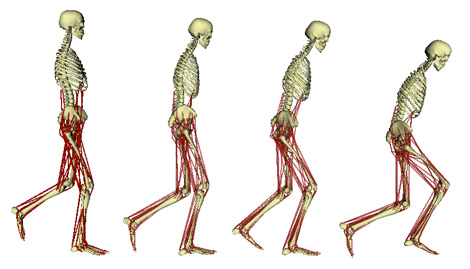Rehabilitation
A broad range of disorders, including cerebral palsy, osteoarthritis, stroke, spinal cord injury, and Parkinson’s, can limit mobility. Computer modeling and simulation, enabled by OpenSim, allows researchers and clinicians to uncover the mechanisms that underlie movement disorders and design effective treatments, like strengthening exercises or gait retraining.
Smarter Rehab: How much muscle strength is required to walk in a crouch gait?

Cerebral palsy is a neurological disorder that affects muscle control during movement, and consequently leads to a variety of pathological gait patterns. One common movement pattern is called crouch gait, defined as excess flexion or bending of the knee joint during walking. One hypothesis for why children walk in crouch gait is that the muscles responsible for extending the knee joint are weak. Katherine Steele of Stanford University and Marjolein van der Krogt of the VU University Medical Center are using OpenSim to understand how much muscle strength is needed to walk in a crouch gait as compared to an unimpaired gait.
The research team used OpenSim to generate simulations of gait for three unimpaired children and nine children who walked in a crouch gait. They tested weakening the major muscle groups in the lower leg. Each muscle group was successively weakened until the model was no longer able to track a subject’s gait kinematics.
Surprisingly, subjects were able to compensate for weakness of all the major leg muscles by increasing the activation of synergistic muscles that performed the same function. They also found that walking in a crouch gait was possible with greater weakness of the gluteus medius, a hip extensor muscle, and the plantar flexors or calf muscles. This suggests that crouch gait might be a compensation for gluteus medius or plantar flexor weakness and that these muscles would be good candidates for strength training.
Visit Steele and van der Krogt’s project on SimTK.org to find out more: http://SimTK.org/home/crouch_strength


